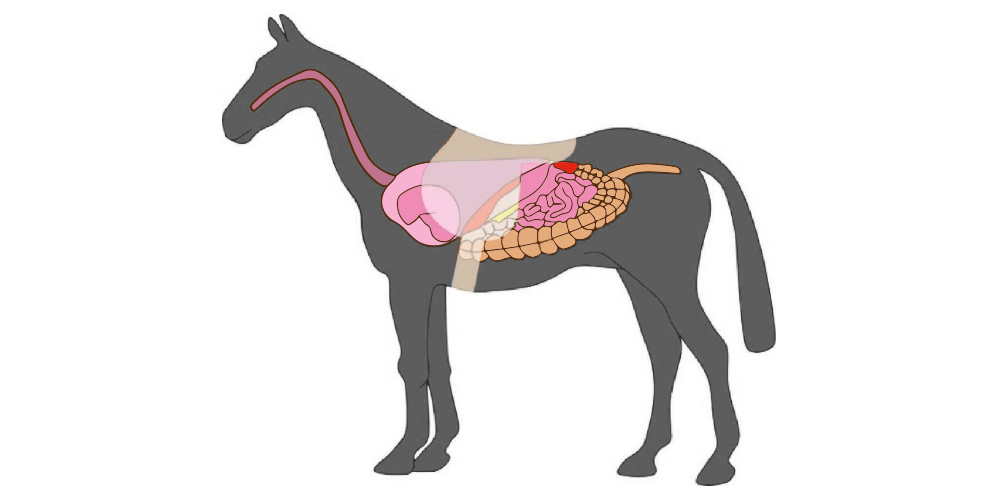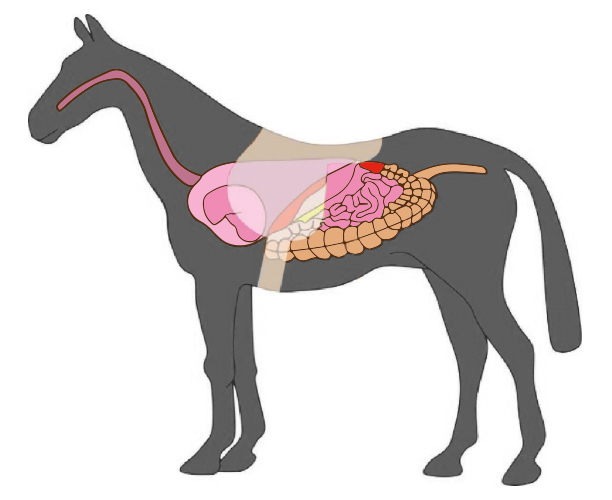
One area of equine health much more recognised in recent years is the risk of stomach ulcers in horses, known as EGUS (Equine Gastric Ulcer Syndrome). Once thought a condition primarily of racehorses, where studies showing up to 100% of those tested affected are not uncommon. However increasingly EGUS is recognised in all horses and ponies, with an incidence of 67% in endurance horses, and around 60% in showing, leisure and competition horses. Risk factors recognised as increasing the likelihood of a horse developing ulcers are linked to the modern equine lifestyle, such as high levels of concentrate feed, intense exercise, periods of time stabled, travel and changing riders.
Will you know if your horse has an ulcer? Research shows that over half of all affected horses show no clinical signs at all and are, effectively, suffering in silence. Therefore we should consider EGUS a risk in all equines, but what are the signs we are looking for?
 Stomach : Position of saddle over stomach.
Stomach : Position of saddle over stomach.
 Stomach : Position of saddle over stomach.
Stomach : Position of saddle over stomach.
 Stomach : Position of saddle over stomach.
Stomach : Position of saddle over stomach.
Signs may include a dull coat, poor condition, inability to settle and digestive dysfunction such as loose droppings. When stabled, signs previously considered ‘vices’ are now understood to be indications of suspected ulcers, and these include box walking, crib biting and weaving. When ridden, the horse is likely to be hyper-sensitive to the leg and girth tightening, due to the position of the stomach which lies in close proximity to the girth. Consequently they are also likely to take longer to warm up and work correctly, showing resistance and signs of discomfort.
The equine stomach is relatively small, shaped like a rugby ball and split into two sections, referred to as the Squamous and the Glandular (or Non-Squamous) regions. The Glandular region is well protected from the hydrochloric stomach acid which naturally sits there; while the Squamous region is delicate and at risk from acid attack. Ulcers may appear in either region, and are thought to have distinctly different aetiology. For this reason EGUS is now sub-divided into two different groups dependent on where they occur.
ESGD (Equine Squamous Gastric Disease) are those which occur in the delicate squamous layer at the top of the stomach, and are commonly referred to as ‘splash ulcers’. Put simply, if a horse is exercised on an empty stomach natural stomach acid can splash up and attack the unprotected layer. ESGD are by far the more common form of ulcers we typically see. Conversely, EGGD (Equine Glandular Gastric Disease) occurs within the protected glandular layer towards the bottom of the stomach, and appears closely linked to the use of NSAIDs in horses, such as bute.
Veterinary intervention is often sort, and a short course of a proton pump inhibitor, omeprazole, may be of benefit. However researchers agree that unless that is accompanied by dietary support then ulcers are likely to reoccur. Regularly going back to the omeprazole treatment is not advised, partly as it is prohibitively expensive for owners, but also because there are concerns over long term use of omeprazole and its potential impact on long term health. So what can we do from a dietary point of view to minimise reoccurrence?
Horses evolved to be trickle grazers, eating for 16-18 hours a day on highly fibrous material and, as such, they would pretty much always have something in their stomach and passing through the digestive tract. The modern performance diet, where horses receive a few small bucket feeds through the day, usually including highly starchy cereals, is completely alien to the horse’s evolution. Cereals are known to increase the risk of ulcers due to their starch content. Small bucket feeds are also a major factor, as they leave the stomach empty for periods of time which allows the stomach acid to splash up to the unprotected squamous layer. One simple thing all horse owners can do is to ensure their horse receive plenty of forage, and certainly to ensure they receive a small, high fibre, pre-exercise feed, such as a handful or two of chaff. This pre-exercise feed then physically lies on the stomach acid effectively acting as a natural mat, and so preventing acid splash.
Overall we should minimise concentrate feed, and increase the fibre ration, so we get back to a more natural high forage, low cereal diet. A high fibre diet can provide sufficient energy for the majority of equine disciplines, and if the horse or pony does need extra energy this is best provided by the addition of oil rather than cereals. Don’t forget, with a high forage diet it is important to balance nutrients to ensure all micro-nutrient requirements are met.
In conclusion we can see that EGUS is commonly occurring and all of us as horse owners should be taking simple steps to prevent it. Feed a high fibre, low concentrate diet, and ensure forage is constantly available. If bucket feeds are required they should be fibre based, and split between multiple feeds during the day. Don’t forget the small pre-exercise feed to provide a gastric mat against acid splash. For at risk horses it is suggested to provide the key nutritional tools recommended to support a healthy gastric environment.
NAF © 2024 | NAF is a trading name of Greencoat Limited, registered in England & Wales. Greencoat Ltd - Registered address: Weston Centre, 10 Grosvenor Street, London, W1K 4QY. Registered Number: 1560 108. Registered in England & Wales.Number: 1560108 VAT Registration Number: 378 9295 80